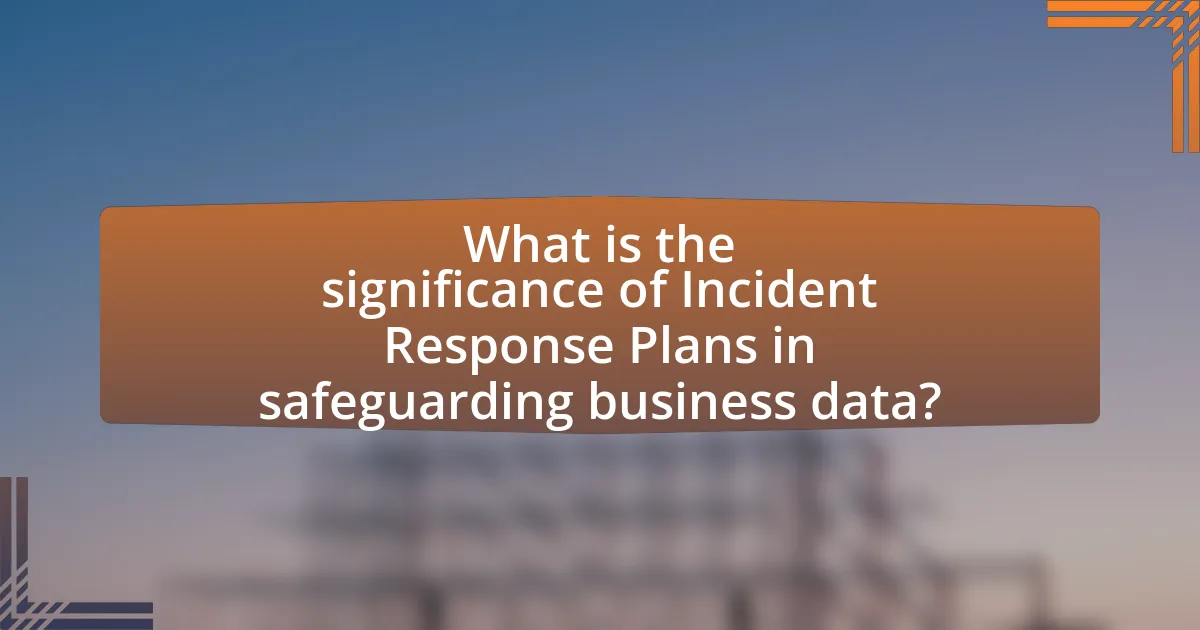Incident Response Plans (IRPs) are essential frameworks for businesses to effectively manage and mitigate security incidents, thereby safeguarding sensitive data. This article explores the significance of IRPs, highlighting their role in minimizing the financial impact of data breaches, which can be reduced by approximately $1.23 million with a well-defined plan. Key components of effective IRPs, including preparation, detection, containment, eradication, recovery, and post-incident review, are discussed, along with the importance of employee training and regular updates to ensure preparedness. Additionally, the article addresses common challenges businesses face in implementing IRPs and offers practical strategies to enhance their effectiveness in protecting business data.

What is the significance of Incident Response Plans in safeguarding business data?
Incident Response Plans (IRPs) are crucial for safeguarding business data as they provide a structured approach to identifying, managing, and mitigating security incidents. By having a well-defined IRP, organizations can minimize the impact of data breaches, reduce recovery time, and ensure compliance with regulatory requirements. For instance, a study by the Ponemon Institute found that organizations with an incident response plan can reduce the average cost of a data breach by approximately $1.23 million compared to those without such plans. This demonstrates that effective incident response not only protects sensitive information but also significantly lowers financial risks associated with data breaches.
How do Incident Response Plans function in a business context?
Incident Response Plans (IRPs) function in a business context by providing a structured approach to identifying, managing, and mitigating security incidents. These plans outline specific roles, responsibilities, and procedures that organizations must follow when responding to incidents, ensuring a coordinated and efficient response. For example, a study by the Ponemon Institute found that organizations with an established IRP can reduce the average cost of a data breach by approximately $1.23 million compared to those without one. This demonstrates that effective IRPs not only enhance incident management but also significantly minimize financial losses associated with data breaches.
What are the key components of an effective Incident Response Plan?
An effective Incident Response Plan (IRP) includes key components such as preparation, detection and analysis, containment, eradication, recovery, and post-incident review. Preparation involves establishing policies, procedures, and training for the response team. Detection and analysis focus on identifying and understanding incidents through monitoring and reporting mechanisms. Containment strategies aim to limit the impact of an incident, while eradication ensures that the root cause is removed. Recovery processes restore systems and operations to normal, and post-incident review evaluates the response to improve future plans. These components are essential for minimizing damage and ensuring a swift recovery, as evidenced by organizations that implement structured IRPs experiencing 50% faster recovery times compared to those without.
How do these components interact during a data breach?
During a data breach, the components of an incident response plan, including detection, containment, eradication, recovery, and lessons learned, interact in a systematic manner to mitigate damage. Detection involves identifying the breach through monitoring systems, which triggers the containment phase where immediate actions are taken to limit the breach’s impact. Following containment, eradication focuses on removing the threat from the environment, ensuring that vulnerabilities are addressed. Recovery then restores systems to normal operations while ensuring data integrity. Finally, the lessons learned phase analyzes the incident to improve future response efforts. This structured interaction is essential for minimizing the breach’s effects and enhancing overall data security, as evidenced by studies showing that organizations with robust incident response plans can reduce the average cost of a data breach by up to 50%.
Why are Incident Response Plans essential for businesses?
Incident Response Plans are essential for businesses because they provide a structured approach to managing and mitigating the impact of security incidents. These plans enable organizations to respond swiftly and effectively to breaches, minimizing potential damage and recovery time. According to a study by the Ponemon Institute, organizations with an incident response plan can reduce the average cost of a data breach by approximately $1.23 million. This demonstrates that having a well-defined response strategy not only protects sensitive data but also significantly lowers financial risks associated with incidents.
What risks do businesses face without an Incident Response Plan?
Businesses without an Incident Response Plan face significant risks, including prolonged downtime, financial losses, and reputational damage. The absence of a structured response can lead to delayed recovery from incidents, which, according to a study by the Ponemon Institute, indicates that the average cost of a data breach can exceed $4 million. Additionally, without a plan, organizations may struggle to comply with regulatory requirements, resulting in potential fines and legal repercussions. Furthermore, the lack of preparedness can exacerbate the impact of cyberattacks, leading to loss of customer trust and competitive advantage.
How can an Incident Response Plan mitigate potential data loss?
An Incident Response Plan (IRP) mitigates potential data loss by providing a structured approach to identifying, responding to, and recovering from security incidents. The IRP outlines specific procedures for detecting breaches, containing threats, and restoring data, which minimizes the duration and impact of incidents. For instance, organizations with a well-defined IRP can reduce the average time to identify a breach from 197 days to 69 days, as reported by IBM’s 2021 Cost of a Data Breach Report. This rapid response capability helps prevent extensive data loss and ensures that critical information is preserved and restored efficiently.

What are the stages of an Incident Response Plan?
The stages of an Incident Response Plan are preparation, identification, containment, eradication, recovery, and lessons learned. Preparation involves establishing and training the incident response team and developing policies. Identification focuses on detecting and confirming incidents. Containment aims to limit the impact of the incident. Eradication involves removing the cause of the incident. Recovery is the process of restoring systems and services to normal operations. Finally, lessons learned include reviewing the incident to improve future response efforts. These stages are critical for effectively managing and mitigating incidents, ensuring business data remains secure.
What are the phases involved in incident response?
The phases involved in incident response are preparation, detection and analysis, containment, eradication, recovery, and post-incident review. Preparation involves establishing and training the incident response team and developing response plans. Detection and analysis focus on identifying and assessing incidents to determine their nature and impact. Containment aims to limit the damage by isolating affected systems. Eradication involves removing the cause of the incident, while recovery focuses on restoring systems to normal operations. Finally, the post-incident review assesses the response to improve future incident handling. These phases are essential for effectively managing security incidents and minimizing their impact on business data.
How does preparation influence the effectiveness of an Incident Response Plan?
Preparation significantly enhances the effectiveness of an Incident Response Plan by ensuring that organizations can respond swiftly and efficiently to security incidents. When an organization invests time in preparation, it establishes clear protocols, assigns roles, and conducts training exercises, which leads to a more coordinated response during actual incidents. For instance, a study by the Ponemon Institute found that organizations with well-prepared incident response teams can reduce the average cost of a data breach by approximately $1.23 million compared to those without such preparation. This demonstrates that thorough preparation not only streamlines the response process but also mitigates financial and reputational damage during incidents.
What actions are taken during the detection and analysis phase?
During the detection and analysis phase, organizations implement monitoring tools to identify potential security incidents and analyze the data to determine the nature and scope of the threat. This phase involves collecting logs, alerts, and other relevant data to assess anomalies and validate incidents. For instance, security information and event management (SIEM) systems are often utilized to aggregate and analyze security data in real-time, enabling quicker identification of breaches. Additionally, threat intelligence feeds may be integrated to enhance the analysis by providing context on known vulnerabilities and attack patterns, thereby improving the accuracy of incident detection.
How is recovery managed after an incident?
Recovery after an incident is managed through a structured process that includes assessment, containment, eradication, and restoration. First, organizations assess the extent of the damage to understand the impact on systems and data. Next, containment measures are implemented to prevent further damage, followed by eradication of the root cause of the incident. Finally, restoration involves bringing systems back online and ensuring data integrity, often guided by an incident response plan that outlines specific recovery procedures. According to the National Institute of Standards and Technology (NIST), effective incident recovery is critical for minimizing downtime and ensuring business continuity, highlighting the importance of having a well-defined incident response plan in place.
What steps are involved in restoring business operations post-incident?
Restoring business operations post-incident involves several critical steps: assessing the damage, prioritizing recovery efforts, implementing recovery strategies, and conducting a post-incident review. First, organizations must assess the extent of the damage to understand the impact on operations. Next, prioritizing recovery efforts ensures that the most critical functions are restored first, minimizing disruption. Implementing recovery strategies, such as data restoration and system repairs, follows to bring operations back online. Finally, conducting a post-incident review allows organizations to analyze the response and improve future incident response plans. These steps are essential for effective recovery and resilience in business operations.
How can businesses learn from incidents to improve future responses?
Businesses can learn from incidents to improve future responses by conducting thorough post-incident analyses. This process involves reviewing the incident’s timeline, identifying weaknesses in the response, and documenting lessons learned. For instance, a study by the Ponemon Institute found that organizations that implement post-incident reviews can reduce the average cost of data breaches by 30%. By analyzing specific incidents, businesses can refine their incident response plans, enhance training for staff, and invest in better technology to prevent similar occurrences in the future.

What best practices should businesses follow when developing Incident Response Plans?
Businesses should follow several best practices when developing Incident Response Plans (IRPs) to ensure effective management of security incidents. First, organizations must conduct a thorough risk assessment to identify potential threats and vulnerabilities, which allows for tailored response strategies. Second, businesses should establish a clear communication plan that outlines roles and responsibilities during an incident, ensuring that all team members understand their tasks. Third, regular training and simulations are essential to prepare staff for real incidents, as studies show that organizations with trained personnel respond more effectively to breaches. Fourth, businesses must continuously review and update their IRPs based on lessons learned from past incidents and evolving threats, as the cybersecurity landscape is dynamic. Lastly, integrating legal and regulatory compliance into the IRP is crucial, as non-compliance can lead to significant penalties and reputational damage. These practices collectively enhance an organization’s ability to respond to incidents swiftly and effectively, safeguarding business data.
How can businesses ensure their Incident Response Plans are effective?
Businesses can ensure their Incident Response Plans are effective by regularly updating and testing these plans through simulations and real-world scenarios. Regular updates are essential because the threat landscape evolves rapidly; for instance, a 2022 report by IBM found that organizations with tested incident response plans reduced the average cost of a data breach by $1.2 million. Additionally, conducting tabletop exercises allows teams to practice their response in a controlled environment, identifying gaps and improving coordination. Furthermore, incorporating feedback from these exercises into the plan enhances its relevance and effectiveness, ensuring that businesses are prepared for actual incidents.
What role does employee training play in incident response preparedness?
Employee training is crucial for incident response preparedness as it equips staff with the necessary skills and knowledge to effectively identify, respond to, and recover from security incidents. Trained employees are more likely to recognize potential threats, follow established protocols, and minimize the impact of incidents, thereby enhancing the overall security posture of the organization. Research indicates that organizations with comprehensive training programs experience a 50% reduction in the time taken to detect and respond to incidents, demonstrating the direct correlation between training and preparedness.
How often should Incident Response Plans be reviewed and updated?
Incident Response Plans should be reviewed and updated at least annually. Regular reviews ensure that the plans remain effective and relevant in the face of evolving threats and changes in the business environment. Additionally, any significant changes in the organization, such as new technologies, processes, or personnel, should trigger an immediate review and update of the Incident Response Plan to maintain its effectiveness.
What common challenges do businesses face in implementing Incident Response Plans?
Businesses commonly face challenges such as lack of resources, insufficient training, and inadequate communication when implementing Incident Response Plans. Resource constraints often limit the ability to allocate necessary personnel and technology for effective incident response. Insufficient training can lead to unprepared staff who may not know how to execute the plan during an incident, resulting in delays and increased damage. Additionally, inadequate communication among teams can hinder coordination and response efforts, making it difficult to manage incidents effectively. These challenges can significantly impact the overall effectiveness of an Incident Response Plan, as highlighted by studies indicating that organizations with well-trained teams and clear communication protocols are more successful in mitigating incidents.
How can businesses overcome resource limitations in incident response?
Businesses can overcome resource limitations in incident response by prioritizing the development of a comprehensive incident response plan that leverages automation and collaboration tools. Implementing automation can streamline repetitive tasks, allowing teams to focus on critical issues, while collaboration tools enhance communication and coordination among team members, even in resource-constrained environments. According to a report by the Ponemon Institute, organizations that have a well-defined incident response plan can reduce the cost of a data breach by an average of $1.23 million, demonstrating the financial benefits of effective resource management in incident response.
What strategies can be employed to enhance communication during an incident?
To enhance communication during an incident, organizations should implement clear communication protocols, utilize multiple communication channels, and establish a designated incident response team. Clear communication protocols ensure that all team members understand their roles and responsibilities, which minimizes confusion and streamlines information flow. Utilizing multiple communication channels, such as emails, messaging apps, and conference calls, allows for timely updates and ensures that critical information reaches all stakeholders. Establishing a designated incident response team ensures that there is a focused group responsible for managing communication, which can lead to more effective and coordinated responses. These strategies are supported by research indicating that effective communication during incidents can significantly reduce response times and improve overall incident management outcomes.
What practical steps can businesses take to strengthen their Incident Response Plans?
Businesses can strengthen their Incident Response Plans by conducting regular risk assessments to identify vulnerabilities and potential threats. This proactive approach allows organizations to tailor their response strategies effectively. Additionally, implementing comprehensive training programs for employees ensures that all staff members understand their roles during an incident, which is crucial for a coordinated response. Regularly testing the Incident Response Plan through simulations or tabletop exercises helps identify gaps and areas for improvement, ensuring the plan remains effective and up-to-date. Furthermore, establishing clear communication protocols enhances information sharing during an incident, facilitating quicker decision-making. According to a report by the Ponemon Institute, organizations that conduct regular incident response training experience a 30% reduction in the cost of data breaches, highlighting the importance of these practical steps.
